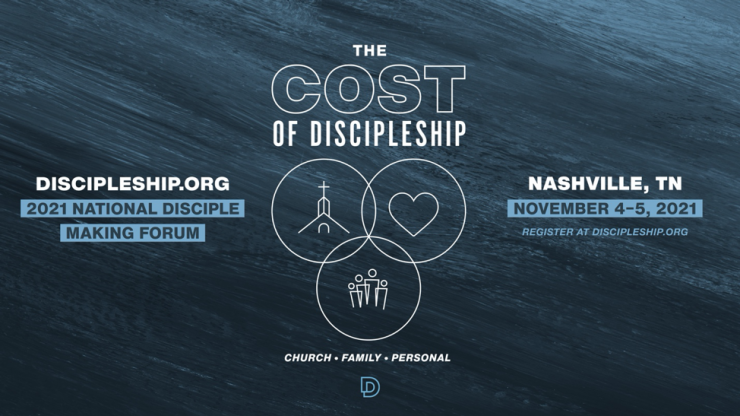Jesus Is the Gospel
An excerpt from Evangelism or Discipleship by Bill Hull and Bobby Harrington
The root word for “evangelism” is euangelion. It is also the root word for “the gospel.” Euangelion simply means, “good news.” In a sense, evangelism is “good news-ing people,” telling them about Jesus, who is Himself, the “Good News.” Following this logic, evangelism and the gospel point us to Jesus.
A proper understanding of Jesus as the gospel helps us connect evangelism and conversion to discipleship. The way we present the gospel often causes a separation between evangelism and discipleship. It is easy for us to start at the cross and ask for a decision, while skipping the life, the teaching, the resurrection and current reign of King Jesus, to say nothing of His teaching on what it means to be a disciple. Some actually think that a gospel of the cross is all that is necessary for evangelism.
Granted, just explaining what Jesus did on the cross and asking for a response or decision are much simpler. But it leaves the impression with too many people that conversion is the finish line, not the starting line. In this chapter, we want to suggest a fuller gospel presentation and an invitation to a fuller, covenant-making response that will link evangelism and discipleship. Let’s take a brief look at how this coupling works, using three passages from the Gospel of Mark.
Lets start with the concept of the gospel. What is it and what does it mean to present the gospel to others? A brief look at the Gospel of Mark indicates that the gospel is much more than just the cross.
Mark begins his Gospel by saying that the gospel is summed up in Jesus, as everything about Him is the gospel:
“The beginning of the gospel of Jesus Christ, the Son of God” (Mark 1:1, ESV).
The whole book of Mark is about Jesus, who in His person is the gospel. Evangelism, Mark shows us, is a proclamation of the kingdom of God and the invitation to repent and believe in the gospel.
“The time is fulfilled, and the kingdom of God is at hand; repent and believe in the gospel” (Mark 1:14-15).
When Jesus makes this invitation, He has yet to die for the sins of people, but He still invites them to believe in the gospel. Here, the gospel is about Jesus, His kingdom and the need for repentance.
Then Mark tells us that the gospel includes the call to make radical decisions of obedience. We cannot be true disciples unless we are willing to lose our life for the gospel:
“Then He called the crowd to Him along with His disciples and said: “Whoever wants to be My disciple must deny themselves and take up their cross and follow Me. For whoever wants to save their life will lose it, but whoever loses their life for Me and for the gospel will save it” (Mark 8:34-35, NIV).
The gospel, as Jesus teaches us here, is unconditional loyalty to Him. As humanity’s true king, he deserves full surrender and loyalty.
So evangelism, as Scripture shows, is the invitation of the gospel to come to Jesus for both salvation and discipleship. Both parts are integral. Again, Mark (and the rest of the New Testament) teaches us that evangelism is an invitation to come to Jesus by faith for a relationship grounded in a willingness to surrender all to be a disciple.
The coupling of these teachings is the whole gospel. At the same time, we want to fully acknowledge that there is a core gospel focused on His grace through the cross. We want to emphasize both.
Over the last 10 years, I (Bill) was fortunate to spend a lot of time with Dallas Willard before he died. It was Dallas who first pointed out to me that one of the reasons why we have a discipleship problem today is because of the way we often present the gospel. Too often, we teach and share a transactional gospel that does not explicitly necessitate obedience to Jesus and a life of being formed into His image. So moving into a more holistic linking of evangelism and discipleship starts with a broader understanding of the gospel.
The Storyline of the Gospel
Let us be clear. At a foundational level, Jesus’ cross is the core gospel (1 Cor. 15:1-8). We are saved by grace through faith in this gospel (Rom. 1:16, 3:20-26; Eph. 2:8-9). However, the cross only makes sense only in the light of the story line of God, humanity and His Kingdom.
The storyline of the gospel fits within the broader story of God’s relationship with humanity and the kingdom, as outlined in the Old and New Testaments. Below, we’ve summarized the key movements of that story.
• CREATION: God is holy and loving; He created us for Himself in paradise.
• FALL: We rebelled against God, under Satan’s influence. We are now all separated from Him, gravitating to sin in thought, word and deed; yet God graciously promised Abraham that He would bless the world through him. Abraham believed God and became the father of the nation of Israel and God’s promises, including a future kingdom that would never end.
• REDEMPTION: God sent Jesus into the world to establish His kingdom as the Messiah of Israel and our King. This incarnational move fulfilled the promise to Abraham and the prophecies in the Old Testament scriptures. Jesus took the penalty for our sin on the cross, rose from the dead, and defeated Satan. He is The Way we restore our relationship to God and enter the kingdom. Jesus ascended to heaven, where He now reigns. He is the Savior, King of Kings and Lord of Lords.
• RESTORATION Jesus redeems those who turn from their sin (repent), trust and follow Him, and obey all of His teachings (by faith). They enter His kingdom now. He will come back to judge the living and the dead and will take His obedient children into His eternal kingdom, the renewed created order or paradise of God.
This summary illustrates the broad story line of the gospel. All of God’s promises for humanity are fulfilled in Him. Within the story of Jesus and the kingdom is the most central part of the gospel—His victory over sin and death for the sake of humanity through the cross. The core gospel is central, but the full gospel is bigger than its core. Again, we’re emphasizing both.
The Heart of the Gospel
Let’s look within the storyline of Jesus at the core gospel of His cross. Our eternal destiny depends on whether or not we are saved by God through Jesus in His cross—in His death, burial, and resurrection. The passage in 1 Cor.15: 1-6 shows us that this focus is the key or foundational item of our faith:
“Now I would remind you, brothers, of the gospel I preached to you, which you received, in which you stand, and by which you are being saved, if you hold fast to the word I preached to you—unless you believed in vain. For I delivered to you as of first importance what I also received … ” (ESV).
Paul’s language is clear—your faith in Jesus and His work on the cross is the basis of your standing with God. You are saved through it, and there is nothing more important! The passage goes on to summarize the core gospel:
“Christ died for our sins in accordance with the Scriptures, that He was buried, that He was raised on the third day in accordance with the Scriptures, and that He appeared to Cephas, then to the 12. Then He appeared to more than 500 brothers at one time, most of whom are still alive, though some have fallen asleep” (ESV).
Here, the gospel focuses on Jesus Christ’s death for our sin. But even this gospel is not just His death—it includes His burial and resurrection—and how they are in accordance with the broader story of Scripture. Jesus is God’s son, and He conquered sin and death. He is now the reigning king of humanity, and His kingdom will be fully consummated when He returns.
This focus offers the broader picture assumed throughout the Bible and in Paul’s letter to church of Ephesus: “… by grace you have been saved through faith. And this is not your own doing; it is the gift of God” (Eph. 2:8, ESV). John 3:16 also sums it up: “For God so loved the world that He gave his only Son, that whoever believes in Him should not perish but have eternal life” (ESV).
This core gospel is fundamental to Jesus, but He is more than just His cross. He came to proclaim a kingdom and invite us into salvation and discipleship.
Please note this truth: This gospel of Jesus requires discipleship. Jesus does not just want a transaction where He takes away our sin—He wants to take away our sin and transform our lives. He doesn’t just want to give us life in eternity; He wants to renew our lives in this world. The invitation is salvation and life under His kingship, where we are transformed. It is a response for now and for eternity. As leaders, we must teach this whole gospel.
As those seeking true discipleship in His kingdom, we must surrender to King Jesus. To fully surrender, we need help. God leads us to Jesus and promises to be present by His Spirit (Eph. 1:13-14). But we also need people to enter into our lives to help us make the decision to commit our lives to trust and follow Jesus—and to help us obey all of His teachings.
Evangelism and a Covenant Commitment
We think the concept of a covenant commitment is also important in this discussion and in the linkage of evangelism and discipleship. Covenants are a big deal in the Bible. A covenant is a special relationship where parties formally commit themselves to each other. It is not a transaction, but a deeply meaningful relationship. A covenant is an agreement where God invites us, leads us and freely binds Himself to us. We respond, as His gracious Spirit leads, and commit ourselves to Him. King Jesus calls to us to complete trust and surrender.
Think of the Israelites and the covenant God called them into in the desert at Mount Sinai (Deut. 5:1 ff). God delivered the Israelites out of Egypt by His mercy and grace and committed Himself to them. But in this relationship, He made it clear that He expected the people to walk with and follow Him. He expected them to fully obey Him and carefully follow His commands (Deut. 28:1-2). Covenants are like that—they are not just transactions where we make a deal with vague promises to somehow follow up on it. In the Bible, God graciously offers covenants, but He calls for a covenant response, a whole life commitment to His covenant offers.
Think of a wedding ceremony covenant. It is a good, everyday analogy. Both of us have performed many wedding ceremonies. According to tradition, we ask the man if he will “take this woman to be his wife, promising before God, his family, and friends that he will stay with her in sickness and in health, in prosperity and in adversity, so long as they both shall live.” Then we turn and ask the woman the same thing. In this pledge, the marriage ceremony becomes a covenant, an agreement between two parties, where they pledge themselves to each other. It is not a transaction. It is two people entering into a deeply personal commitment to one another. Covenants, like wedding ceremonies, involve commitment, confession and physical expression.
Just like with a wedding ceremony, dedication to Jesus is a deeply personal commitment. God is the initiator: He sent His son for us and woos us by His Spirit. He promises forgiveness, His presence, and life in His kingdom. We respond with faith, which is to be a deep, lifelong commitment to “trust, follow, and obey.” Once you enter into the covenant relationship, your life will never be the same.
We see evangelism as that part of discipleship where people are invited to enter into a covenant relationship with the Father, Son and Holy Spirit. According to Matt. 28:18-20, a person makes the decision to trust and follow Jesus (confirmed in baptism) and also commits to obey all of His teachings (true discipleship). This is an invitation to a covenant relationship.
As these examples in Scripture show us, God is the true power source in the covenant. Through Jesus, He promises that we receive forgiveness of all sins, the indwelling presence of His Holy Spirit, life in His kingdom now, and eternal life in His heavenly kingdom forever. We enter into this new covenant by turning to Him from sin (repentance), confessing with our mouths our faith in Jesus, and then by making our faith commitment to Him concrete in baptism.
How do we help people place their faith in Jesus? We recommend a covenant commitment to Jesus as our Savior and King (Lord) in the following fashion. We see this surrender as having three key essentials that are practiced in community:
1. Commitment. A person will consciously make the decision to repent of his sins and turn to God through Jesus (Acts 26:20).
2. Confession. A person will express out loud the confession of his heart that Jesus is King (Lord) and call on His name (Rom. 10:9-10, Acts 22:16, Acts 16:30-33).
3. Physical expression. A person will be baptized as a concrete and covenant expression of her decision to trust and follow Jesus (Matt. 28:19-20, Acts 2:38).
Throughout Scripture, these three elements closely tie together as the way to dedicate yourself to Jesus in a covenant relationship. That relationship with Him is based on God’s grace, by faith, and inherently it helps lead us to discipleship.
The covenant commitment confers a new identity on us. We now live out that identity. Our friend Jeff Vanderstelt has a great way of describing it. God Father makes us family, brothers and sisters to each other, and He calls us to love one another, Jeff explains. The Son is a servant who makes us His servants, as we serve the poor and hurting. And the Spirit empowered the Son’s mission in the world, and now He too empowers us as missionaries who proclaim Jesus in word and deed. Who we are—redeemed followers of King Jesus—determines what we He calls us to do, which is to serve Him.
Think Disciples, Not Steeples
With this whole gospel and a covenant commitment like the one we just described, evangelism will lead to, and be more easily equated with, discipleship. The process takes us beyond a focus on decisions to living out our covenant relationship as disciples. We do not just think about converts, but about developing Christlike people. We don’t just focus on the cross, but on faithful living in light of all that King Jesus teaches.
We like to tell people to “focus on disciples, not steeples.” When you think of your community, your city, and your country and are describing the church, it’s probably natural to think in terms of steeples. For example, a denominational leader will tell you how many churches his denomination has in a state or the nation. We’ve all heard the stat that 20 percent of people in America go to church at least once a month. A national leader will say that only 4 percent of the population belongs to a church. Metrics like these are legitimate, but of only secondary importance.
We prefer to think of how many true disciples are present in any community, city or nation. I (Bill) recall Richard Halverson, former chaplain of the U.S. Senate, answering a question about his church’s location. At the time, he was pastor of Fourth Presbyterian Church in Washington, D.C. Halverson said that although his congregation owned a building at a certain address, his congregation was scattered through the tri-state area (Washington, D.C., and the nearby areas of Maryland and Virginia) with members nestled in homes, community centers, places of commerce and office buildings. He went on to say that the church had people everywhere; they had infiltrated the entire community.
Activated Disciples
For a more visual illustration, think of this “infiltration” as individual lights, each one representing the daily location of a disciple in a particular city. These disciples are present in virtually every domain of the culture.
This reality eliminates what so many in the church consider a problem. The church spends so much time and money marketing its services to the unchurched population hoping to break down barriers that would motivate seekers to visit a church-sponsored event. The irony, of course, is that we are already where we need to be, right next to those who need Christ. Our best strategy is to activate the already present disciples to show the love of Christ and make more disciples in the society. When we activate disciples, we find that the categories, church and state, secular and the sacred, are not true barriers; they all have less power in natural relationships. The church is confused about their real work. Many disciples are inactivated lights. Their light is off or just flickering now and then.
The nature of spirituality as Jesus taught it is that we are the lights of the world that will shine if we don’t snuff them out (Matt. 5:14-16). The real work of the church is to activate those lights through discipleship and unleash them for good works in Christ’s name and for evangelism.
Presenting a full gospel that calls for a total life commitment to Jesus and inviting people to a full covenant response will help us reunite evangelism and discipleship. Jesus is the gospel. We respond to His cross and His person with our whole lives. He wants to save us and remake us in His image. When Jesus is remaking us we become activated lights, outposts of His kingdom within our person-hood and within our lives, every day, everywhere.
We like to tell people, The church is for discipleship, and discipleship is for the world. That means the church works to develop mature and healthy disciples who then reach others in daily life. Christlike people are the point, the primary strategy for reaching others and fulfilling the Great Commission. The Great Commission is the natural extension of why Jesus came. He came because the world needed saving, and that divine purpose as the focus puts all its supporting activity in perspective.
In the next two chapters, we’re exploring two other implications of the tie between evangelism and discipleship. Two Scripture passages speak most plainly about activating the fullness of disciple making:
• The call to make disciples in Matt. 28:18-20
• The preparation of saints to be activated in Eph. 4:12-16






